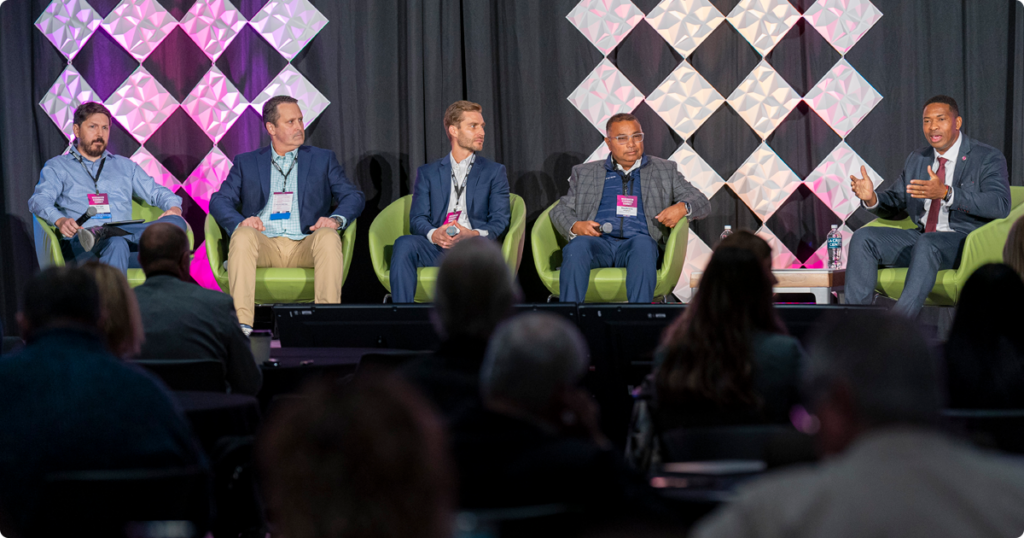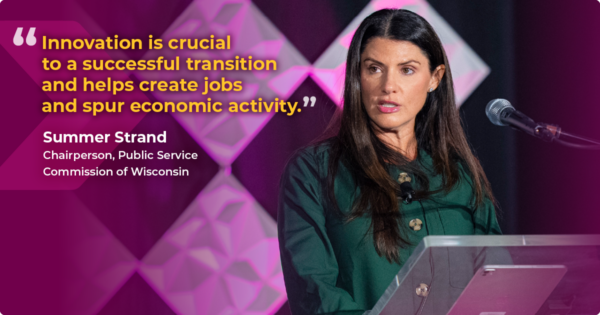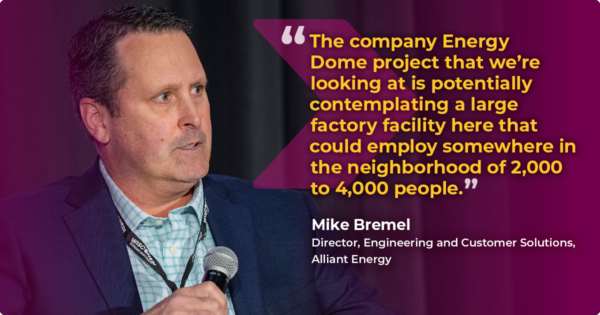
“Powering the Future: Innovation in Clean Energy Technologies,” a panel at the Wisconsin Economic Summit 2024, included (from L to R) Jorge Elizondo, Mike Bremel, Dominick Bindl, Nadeem Afghan, and moderator Francisco Sayu.
Wisconsin is building momentum toward a clean-energy transition by developing cutting-edge, carbon-free technologies while preparing for a regulatory future that embraces those advances.
Innovation will be central to an energy future that is clean and affordable as it builds the state’s workforce, experts said at the third annual Wisconsin Economic Summit, hosted by WEDC in La Crosse Oct. 15-16.
“Innovation is crucial to a successful transition and helps create jobs and spur economic activity,” said Summer Strand, chairperson of the state Public Service Commission. “This clean energy shift is a gradual and complex process that requires significant infrastructure development, as well as technological and policy advancements, to make it effective and affordable.”
 A panel of experts from the energy industry shared how their firms, armed with sophisticated technologies, are tackling the challenge with an eye toward building the workforce and securing the state’s energy future.
A panel of experts from the energy industry shared how their firms, armed with sophisticated technologies, are tackling the challenge with an eye toward building the workforce and securing the state’s energy future.
Dominick Bindl, vice president of technical development at Madison-based Realta Fusion, said his firm is commercializing fusion energy technology to provide carbon-free power and heat to industrial customers.
“The science has matured in a dramatic way,” said Bindl. “A second big inflection point is the maturation of a lot of enabling technologies.”
For example, in the 1980s Bindl said fusion technology required magnets the size of a two-story house. Today, they are smaller than a kitchen in a small condo.
“We’re now in the research and development phase, but even in this early stage of fusion technology development, we have an eye on looking forward to future workforce needs,” he said. “We are looking for partners to help us widen that pipeline to make sure that when we get to the point where fusion’s ready to go, we have the men and women we need.”
At Alliant Energy, officials are also looking at new technologies. Mike Bremel, director of engineering and customer services, said the utility has won a $30 million federal grant for a project using technology from the Italian company Energy Dome.
The system’s unique features will boost grid stability, improve resilience, and deliver enough electricity to power approximately 18,000 Wisconsin homes for 10 hours on a single charge.
The Columbia Energy Storage Project will take energy from the grid and store it by converting CO2 gas into a compressed liquid form. When energy is needed, the system converts the liquid CO2 back to a gas, which powers a turbine to create electricity.
“The company Energy Dome project that we’re looking at is potentially contemplating a large factory facility here that could employ somewhere in the neighborhood of 2,000 to 4,000 people,” Bremel said.
 Nadeem Afghan, CEO of BioFerm Energy Systems, is leading an effort to create environmentally friendly systems that convert organic waste into clean energy using the firm’s anaerobic digesters.
Nadeem Afghan, CEO of BioFerm Energy Systems, is leading an effort to create environmentally friendly systems that convert organic waste into clean energy using the firm’s anaerobic digesters.
“It could be produced with cow waste, it could be produced with industrial waste,” Afghan said, noting BioFerm’s processes produce methane, which is similar to natural gas.
Looking ahead, Afghan said one of the company’s biggest challenges is attracting talented professionals in a tight job market.
“We need chemical engineers and we need lots of smart people, regular plant workers,” he said. “Sometimes we have positions open for a year, and we just don’t get enough candidates.”
As the electric supply diversifies from solar, wind, and other sources, Jorge Elizondo, president of Heila Technologies, is working to optimize the grid to provide reliability.
“We need to add more resources at the edge of the grid, and that will require coordination,” he said. “As we possibly get more solar, green, or energy generators, you need to coordinate, and you need to optimize it.”
Elizondo added: “Our energy system has to change. And it’s changing right now. It has to accommodate more iteration and more distributed generation. … The future is distributed, it’s electric, and it has to be properly coordinated with energy storage.”
